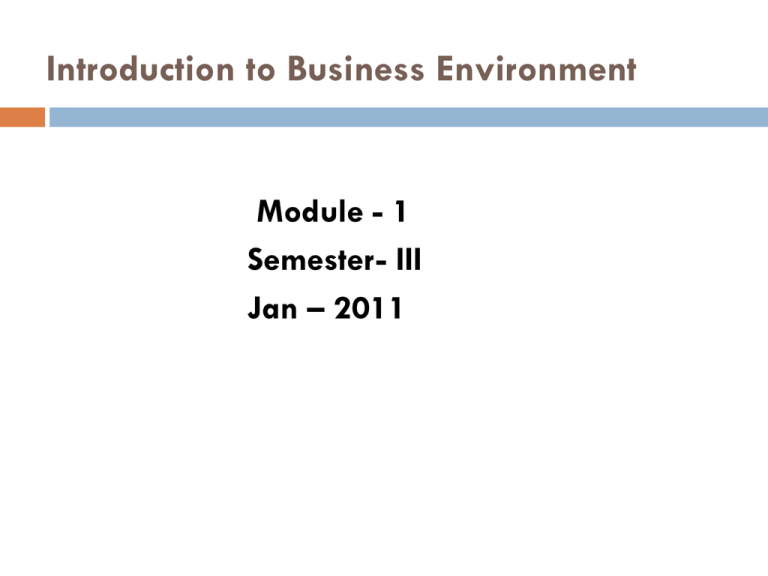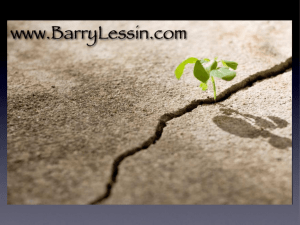
Introduction to Business Environment
Module - 1
Semester- III
Jan – 2011
Instructions
15 sessions
Semester End Exam - 60 marks
Class Participation and Attendance - 10 Marks
Class Test & Case Study - 15 marks
Group Presentations and Vivas - 15 marks
Course Content
Introduction to Business Environment
Contemporary Scenario of Business
Nature of Modern Business
Economic Factors
Socio cultural Factors
Technological Factors
The Fundamentals
Scope and Subject matter of Macroeconomics
An introduction to Economics of Growth and Development
Concept of HDI
Course Content
Macroeconomic Environment of Business : National
Economic System
Economic Fluctuations
Economic Indicators
Macroeconomic Policies: Fiscal & Monetary
Federal Budget
Financial Environment of Business: National
Indian Financial System
Financial Markets
Current trends in Banking
Course Content
Industrial Environment: National
New Industrial Policy-1991
Privatization & Disinvestment
Industrial sickness
Role of Small Scale Industries
India & World
Technology Transfer & Multinational Companies
Strategies for going global
Foreign Investments
India & BOP
India & WTO
Economic Integration
References
Business Environment by Vivek Mittal
Business Environment – Managing in a Strategic
Context by John Kew & John Stredwick
International Business Environment- Francis Cherunilam
Business Environment – Misra & Puri
Essentials of Business Environment – K. Aswathappa
Business Environment - Francis Cherunilam
What is Business???
Business may be understood as the organized efforts of
enterprises to supply consumers with goods and services for
a profit
Contemporary Business goals
Profit (Bottom-line)
Growth
Market Leadership
Customer satisfaction
Employee satisfaction
Quality Products & Services
Service to Society
Characteristics of Business
Change
Govern
ment
Control
Competi
tion
Large
Size
Characteris
tics
of
Business
Diversifi
cation
Globaliz
ation
Informa
tion
Technol
ogy
Indian companies – Fortune 500
8 Indian companies have made it to Fortune 500 list in 2010.
These are:
Indian Oil Corporation
Reliance Industries
Tata Steel
Tata Motors
Bharat Petroleum
Hindustan Petroleum
State Bank of India
ONGC
Contd..
The league of 500 elite companies for 2010 is topped by U.S.
retailer Wal-Mart Stores, followed by oil giant Royal Dutch Shell
and another oil major, Exxon Mobil, in that order.
A total of 54 Chinese companies made it onto the list this year.
Out of which three are in fortune 10 list
Rank
Company
Revenues
($ millions)
Profits ($ millions)
1
Wal-Mart Stores
408214
14335
2
Royal Dutch Shell
285129
12518
3
Exxon Mobil
284650
19280
4
BP
246138
16578
5
Toyota Motor
204106
2256
6
Japan Post Holdings
202196
4849
7
Sinopec
187518
5756
8
State Grid
184496
-343
9
AXA
175257
5012
10
China National Petroleum
(CNPC)
165496
10272
Government Control
To correct market failures in case of externalities
To create stable business conditions (stimulate
Aggregate Demand) through monetary & fiscal
regulation
To provide Public goods
Diversification as a growth strategy
Diversification strategies are used to expand firms'
operations by adding markets, products, services, or
stages of production to the existing business.
When the new venture is strategically related to the
existing lines of business, it is called Concentric
diversification.
Conglomerate diversification occurs when there is no
relationship between the new and old lines of business; the
new and old businesses are unrelated.
Diversification: Vertical or Horizontal?
Vertical integration occurs when firms undertake operations
at different stages of production.
When a firm diversifies closer to the sources of raw materials
in the stages of production, it is following a backward vertical
integration strategy.
Forward diversification occurs when firms move closer to the
consumer in terms of the production stages.
Globalization
It is a phenomenon which permits mobility of factors of
production across globe except land.
Refers to a process of deepening economic integration,
increasing economic and growing economic
interdependence between countries in the world
economy.
Nature of Competition
Monopoly
Duopoly
Monopolistic competition
Oligopoly
BUSINESS CHALLENGES
Managing Bottom line
Meeting stakeholders expectations
Developing and retaining top talent
Creating a customer responsive organization
Diminishing time to market
Market agility
Pricing and quality
What do you mean by Business Environment???
The environment of any organization is “ the aggregate
of all conditions, events and influences that surround and
affect it.”
Characteristics of Business Environment:
Complex
Dynamic
Multi-faceted
Far- reaching impact
Why Study Business Environment
Development of broad strategies to ensure sustainability
To foresee the impact of socio-economic changes at the
national and international levels on firm’s ability
Analysis of competitor’s strategies and formulation of
effective counter measures
To keep oneself dynamic
Types of Environment
Internal Environment
External Environment
Micro
environment
Macro environment
Economic
Non Economic
Internal Environment
Refers to all the factors that are within an organization which impart
strengths or cause weaknesses of strategic nature.
Controllable factors. These include:
Value system
Mission and Objectives
Management Structure and Nature
Components of Internal Environment
Human Resources
Company Image and Brand Equity
Other Factors
Physical Assets and Facilities
R & D and Technological Capabilities
Marketing Resources
Financial Resources
External Environment
Includes all factors outside the organization which
provide opportunities or pose threats to the organization
Uncontrollable factors
Consists of Micro and Macro environment
Micro Environment
“It consists of the factors in the company’s
immediate environment that
performance of the company”.
affect
the
Micro Environment Factors
Suppliers
Customers
Marketing Intermediaries
Competitors
Publics
Financial Community
Micro Environment of a typical car manufacturer
Potential
Supplier
Components
Supplier
Local
Communities
Potential
Customers
Stakeholders
Pressure
Groups
Government
Customers
Car
Manufacturer
Competitors
Car Dealers
Potential
Dealers
For
Customers
For
Supplies
Macro Environment
It comprises general trends and forces that may
not immediately affect the organization but
sooner or later will alter the way organization
operates.
Macro Environment : Economic
Non Economic
Economic Environment
Economic stages that exists at a given time in a country
Economic system that is adopted by a country for example.
Capitalistic, Socialistic or Mixed Economy
Economic planning, such as five year plans, budgets, etc.
Economic policies for example, monetary, industrial and fiscal
policies
Economic Indices such as National Income, Per Capital Income,
Disposable Income, Rate of growth of GNP, Distribution of Income,
Rate of savings, Balance of Payments etc.
Economic Problems
Functioning of economy
Non Economic Environment
Regulatory Environment
Socio- Cultural Environment
Demographic Environment
Technological Environment
Political Environment
Non- Economic Environment
Cultural Environment
Social Customs & Rituals and practices
Lifestyle patterns
Family structure
Role & position of men, women, children and aged in family
& society
Non- Economic Environment
Demographic Environment
Growth of population
Age Composition
Life Expectancy
Sex Ratio
Fertility and Mortality rates
Inter-state migration
Macro Environment
Technological Environment
Sources of technology
Technological development
Impact of technology
Political Environment
Political parties in power
Political Philosophy
Macro Environment
Regulatory Environment
Constitutional framework
Policies relating to pricing and foreign investment
Policies related to the public sector, SSIs, development of
backward areas and control of environmental pollution
International Environment
Important factors that operate at global level which have an impact on organization
are:
Growth of world economy
Distribution of world GDP
International institutions IMF,WTO ILO
Economic relations between nations
Global human resource-nature and quality of skills, mobility of labor
Global technology and quality standards
Global demographic patterns
WTO and its relevance for Indian companies
The main guidelines of WTO are:
Trade without discrimination
Growing market access
Promotion of fair competition
The response of Indian government to WTO constitutes the
following actions
Reduction of tariffs
Opening Indian markets for Global Players
Rationalizing industrial licensing and removal of
controls
on the size of operations
WTO and its relevance for Indian companies
The impact of WTO on Indian companies is likely to include
the following :
Increasing competition
Consolidation of activities in core competence areas
Improvements in infrastructure to negate structural
disadvantages.
Shake out of minor players and M&As to gain global
scale.
Overview of Business Environment
MACRO ENVIRONMENT
ECONOMIC
Environment
MICRO ENVIRONMENT
BUSINESS
Internal Environment
TECHNOLOGICAL
FACTORS
Values,
Mission & Objectives.
Human Resources,
Co. Image & Brand Equity
DEMOGRAPHIC
FACTORS
MARKETING
INTERMEDIARIES
Non - Economic
Environment
SOCIAL
CULTURAL
FACTORS
Environmental Analysis
Environmental Scanning
The process by which organizations monitor their
opportunities and threats affecting their business is
known as environmental scanning
SWOT Analysis
Tools for Analyzing the Environment
PEST Analysis
PESTLE
STEEPLE
S - Social
T - Technological
E - Economic
E - Environmental
P - Political
L - Legal
E - Ethical
Global Competiveness Index
The World Economic Forum has ranked 139
economies in its 2010-2011 Global
Competitiveness Report.
In overall competitiveness India scores a passable
51st place. It ranks notably ahead of Latin
America’s powerhouse Brazil (58) and way ahead
of its neighbors Pakistan (123), Sri Lanka (62) and
Bangladesh (107), but behind China (27).
Switzerland tops the chart and USA is on 4th
position due to economic instability from 2007-10
Delhi tops 2010 ranking of India's most competitive city
Chennai cornered the second position in the list ahead of Mumbai , which
dropped to third place from second position last year.
Chennai's ranking improved on the back of good performance under all the
sub-indices used to benchmark the cities, particularly its educated
workforce and logistics infrastructure, while Mumbai's fall was primarily due
to the worsening state of its physical infrastructure.
Bengaluru is at fourth place in the list, followed by Kolkata, Hyderabad ,
Ahmedabad, Pune, Nagpur and Jaipur.
Ahmedabad and Pune have emerged as the most competitive tier-two cities
in India.
Questions for Case Study
Prepare the environmental threats and opportunity profile
(ETOP) for Arvind Mills.
Prepare the strategic advantages profile (SAP) for Arvind
Mills.
On the basis of ETOP and SAP, propose strategic alternatives
before Arvind Mills.
List down all components of Internal & External Environment of
Arvind Mills & identify its strengths & Weaknesses
Thank You







